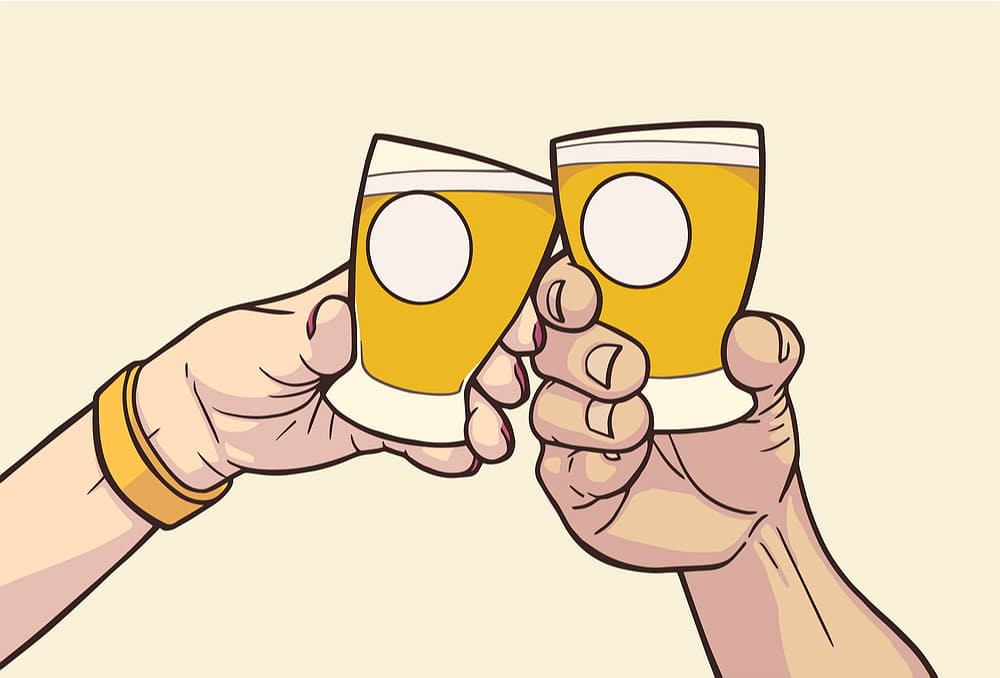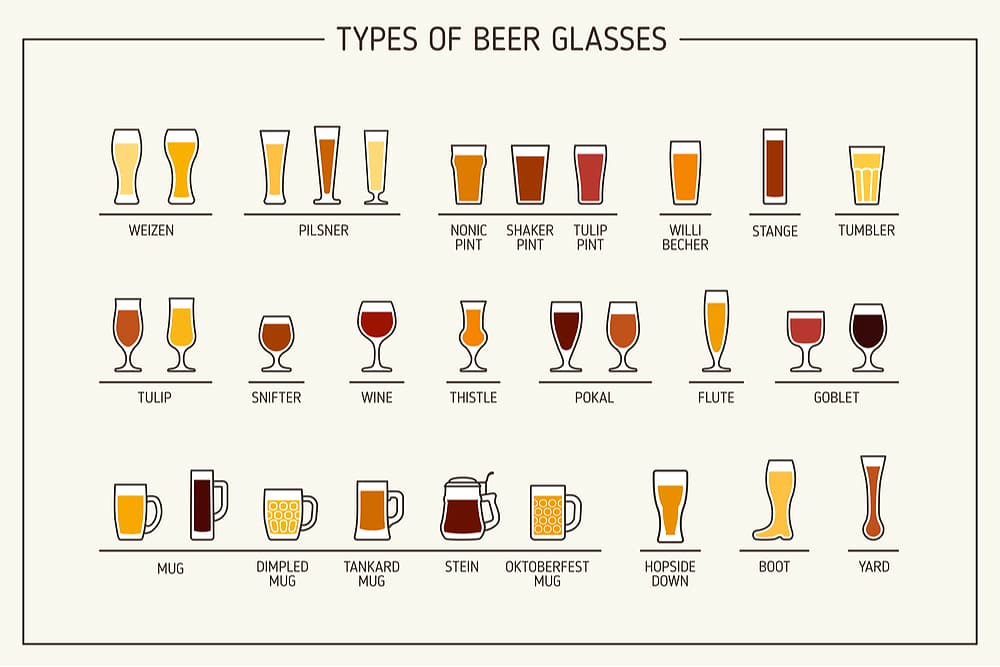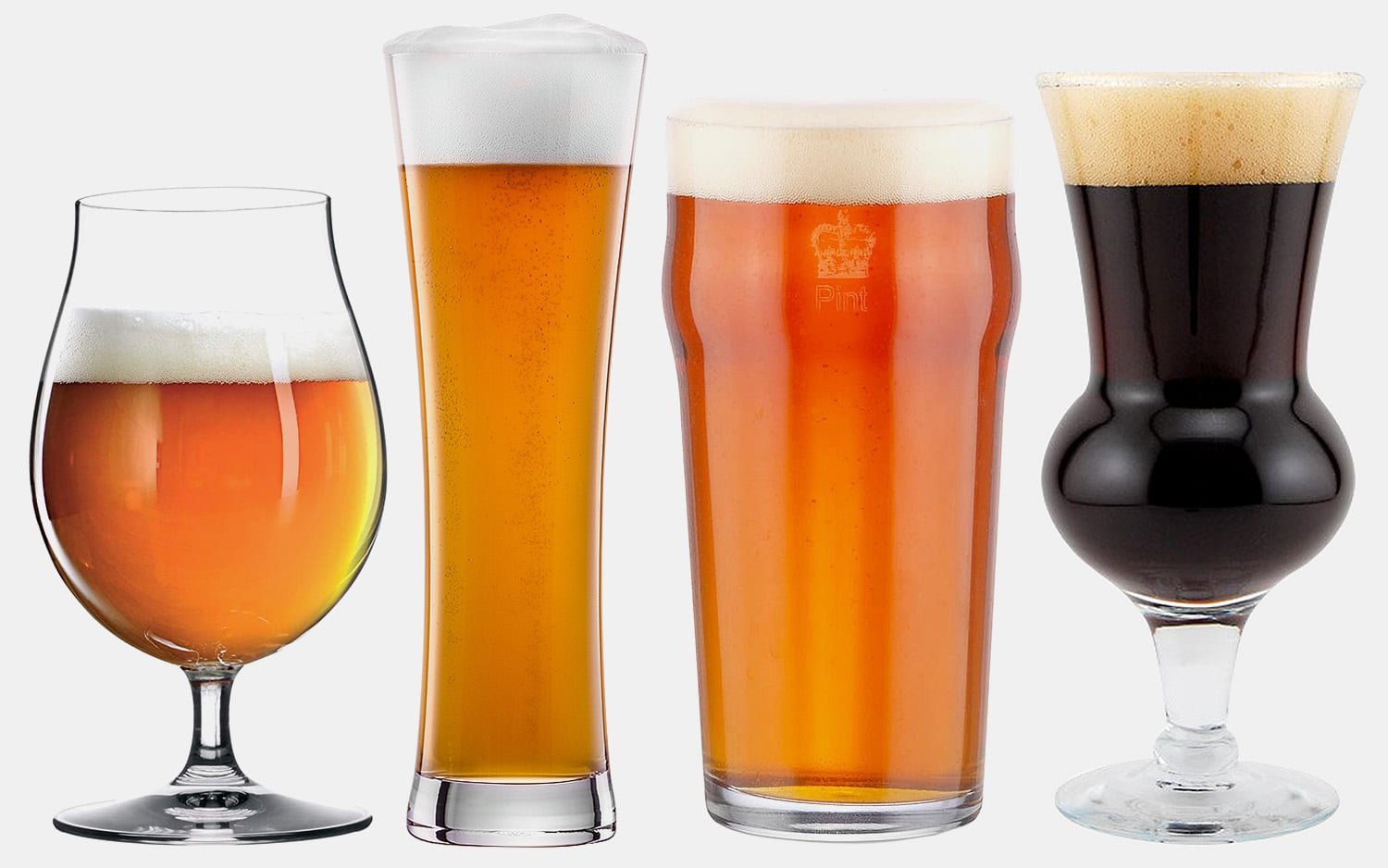To be clear: there is no wrong way to enjoy a beer (with the possible exception of keg stands post-graduation). But there are ways of serving and presenting a beer that will let you get the most out of the experience. If you go to the trouble of seeking out a craft brewer’s latest expression of yeast, malt, and hops, knowing how to properly pour that beer can mean the difference between a pretty good brew and something a little closer to phenomenal.
How to properly pour a beer
Grab your can or bottle and your vessel of choice (you’ll see a few glassware picks below) and prepare to fully enjoy your brew.
Step one:
Tilt the glass 45 degrees.
Step two:
Pour the beer down the side of the glass. If you’re getting a ton of foam, go a little slower. If you see no foam at all, pour a bit faster. Your goal at the end is a little over two fingers of head at the top. Pour until your glass is about half full.
Step three:
When the glass is half full, straighten it and raise the bottle or can, pouring directly into the center. Continue to pour in a continuous flow. You can slow down or speed up the pour to modulate foam, but try not to start and stop. And don’t tilt the bottle or can so much that the beer “glugs” out.
Step four:
If your beer has yeast sediment at the bottom (which happens in bottle-conditioned beers) and you prefer to not have that clouding up your beer, don’t tilt the bottle much steeper than horizontal and go slowly. Most sediment will stay at the bottom where it settled during storage and the bottle’s rounded shoulder will catch the rest, only leaving behind a small amount of precious brew.
Step five:
Stick your face in there and inhale. Then sip. Enjoy.

Why is it better to pour beer into a glass?
Drinking from the can or bottle is certainly more convenient, but there’s this layer of aluminum or glass between you and a full experience. There are three big reasons to properly pour a beer: appearance, aroma, and head.
Appearance:
The brewer responsible for your beer carefully chose the malt blend, picking out roast levels to get not just the right flavor, but the right color — something light and golden for a kölsch, coppery sunset for an IPA, ruby brown for a porter, and so on. Pouring into a glass allows you to see what’s going on in your beer — admiring the rich color, appreciating the hop haze, noting the cloudiness from wheat. All of which adds to the enjoyment before you ever take a sip.
Aroma:
Try eating when you have a cold and everything tastes like a flavorless sponge. Compared to your tongue, your nose is literally millions of times better at detecting the nuances, notes, and elements present in your beer. When you pour beer into a glass, you get the whole story, not just a blast of bitter hops, or a wash of sweet malt.
You’ll never believe an IPA when it claims notes of pineapple, pine, and grapefruit unless you smell it. All your tongue will taste are the acids in the hops, the sugars in the malt. In the case of a gose, you might catch a hint of saltiness too, but you’re never going to get beyond the five basic tastes.
Stick your nose in your glass, however, and you’ll experience everything — chocolate and plum in a stout, caramel toastiness in a märzen (aka Oktoberfest), even barnyard and sourdough in a sour.
Head :
A head on your beer is a good thing. Back when I was bartending at the brewery, many patrons would feel somehow cheated if there was anything greater than a whisper of head on their beer. The head, however, is important. It releases aromas, provides a contrasting texture, and protects your beer from oxygen as you drink — something the brewer has been trying to avoid just about the entire brewing and canning process. (If you’ve ever tasted a beer reminiscent of cardboard, you’ve been enjoying an oxidized beer.)
Drinking a beer with no head only delivers a portion of the experience. While different beers have different ideal levels of foam, you’ll generally be in the right neighborhood if you aim for about two fingers of head at the top of your beer.
Does beer temperature matter?
While some marketing campaigns suggest beer should be enjoyed at the icy temperature of a snow-capped mountain peak, that doesn’t apply to all beers. Yes, if you’re enjoying a good cheap American brew as you mow the lawn, drink that beer cold as you can so it’s refreshing as possible. But craft beers benefit when given a little time to warm up so they can share all their malty, hoppy goodness with you.
While some aficionados will tell you the exact temps at which each and every beer should be consumed (Irish stout at exactly 42.8°F!) in the real world, plunking a thermometer into each beer you drink might be a little obsessive.
For a quick guide, consider that the ideal temps for different beers fall within a range. That range runs between straight-from-the-fridge cold (about 36°F) and cellar temp (about 55°F). The lighter the beer, in both body and ABV, the colder you want it. The heavier the beer, the warmer it should ideally be.
So for brews like wheat beers and pilsners, just a few degrees warmer than what you pull from the fridge is good. For medium beers, like pales, ambers, and sours, let them warm on the counter a little longer. And if you’re going for a thick, chewy barleywine or an aggressive double IPA, let them warm even longer before you open, pour and enjoy.

What glass should I use for my beer?
If you’re setting up a home bar, you might be tempted to replicate what’s going on at your favorite pub. The only problem is, a thick glass pint cup is what your local bar uses not because it’s the best glass for the job, but because a bar is a punishing place for glassware. The good stuff is just going to get broken.
The thick glass of a shaker/pint glass can warm up your beer (and if you freeze it, that can over-chill and even water down your brew). The shape and wide mouth of the pint glass also subdues the aroma. Finally, the ho-hum, all-purpose shape doesn’t pack much visual excitement. However. Pouring into a pint glass is still far better than drinking straight from the can. And pint glasses will still give you the bulk of the benefits of a properly poured beer.
If you’re looking to expand your beer glassware collection, here are four to try. All are made from thinner glass and work to enhance the flavor and aroma of different types of beer.
IPA glass
The wide bowl and narrow opening concentrates all the hoppy aroma of an IPA while the thinner cylinder at the bottom helps keep things frothy. Best for: IPAs
Tulip glass
The large bowl captures aromas while the outward curving lip delivers beer and head simultaneously. The thin stem at the bottom lets you hold your beer without warming it. Best for: Sours. Heavy beers like Belgains, imperial stouts, Scotch Ales.
Pilsner glass
The tall slender glass showcases a pilsner’s bright golden color and lets you see the effervescent bubbles make their long journey to the top. Best for: pilsners, big American lagers, märzen.
Snifter
Originally intended for brandy and the like, the wide bowl is great for concentrating aromas. You can also use your hand to warm your beer up a bit if it hasn’t yet released. Best for: heavy ales like a barleywine, imperial porter or other high-alcohol beers.
Disclosure: Clicking on these links and making a purchase may earn us a small referral fee, at no extra cost to you. Learn more here.


